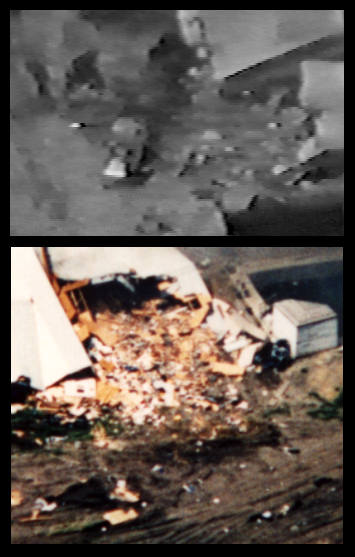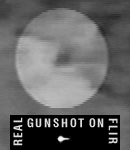
The Waco FLIR Flashes
Flash Location 1
(c) 06/27/00 Ian Williams Goddard
The Waco FLIR (forward-looking infrared) video shows six flashes occurring in one second in one location (Location 1) behind the Mount Carmel Center in Waco, Texas on April 19, 1993 seen here. To see them is to see why some infrared analysts have opined that they are muzzle flashes from a machinegun. However, careful analysis proves that (a ) there is an object in Location 1 with a shape similar to the flashes, (b) nobody is ever seen at or going to or from Location 1, and (c) Location-1 flashes differ from real gunshots on FLIR.
An Object In Flash Location 1
The first image shows a Location-1 flash. The second image is from a visible-light photo of Location 1 seen from a different angle shortly afterwards (from the same photo as the cover of The Davidian Massacre). The flash on the FLIR image is to the left of a tank that moved away by the time the visible-light photo was taken.

Due to the different camera angles, the positions of the same objects in the two images above differ by about 90 degrees. The next animated graphic shows that the FLIR flash lines up with debris seen in the visible-light photo (which is converted to black and white to maintain image integrity with the limited color pallet of the animation format):

A piece of debris with a similar shape as the flash is seen in the same location as the flash. (In the FLIR image, Location 1 is viewed along an oblique angle that foreshortens the distances between the highlighted objects, making them appear closer together than they do as seen from the angle of view in the visible-light photo that looks almost straight down.)
With an object in Location 1 shaped similar to Location-1 flashes, it stands to reason that the flashes are solar reflections on that object. The Location-1 object may have several separate facets, or surface angles, like for example a large glass shard cracked into segments, each with a slightly different slant angle causing solar reflections on them to appear in rapid succession viewed by a FLIR camera on an aircraft moving through the slightly divergent reflected beams.
The Location-1 object might also be a piece of reflective material that flaps in the wind causing a single reflected beam to be swung back and forth over the FLIR sensor as occurred at Location 6. But there is no other indication of anything at Location 1 flapping.
Location-1 Flashes Differ From Real Gunshots
The remarkable feature of Location-1 flashes is that there appear to be six of them within one second, giving them a striking resemblance to machinegun fire. Here we see a slow animation of 14 out of 27 frames within which the flashes occur (bright highlight-circle added by source: Waco: A New Revelation).

Apart from distortions that may result from camera distance and the tiny size of the flashes in the FLIR frame, the shapes of several Location-1 flashes are not significantly different than the reduced sample above of a real gunshot on FLIR. However, the fact that the flashes differ from one another in their brightness, shape, size, and duration suggests that they are not gunfire. To explore this matter I carefully observed flash intensity in each video frame.
The first graph below shows the intensity of brightness at Location 1 during the series of all video frames in which Location-1 flashes appear (as seen here). Location-1 flashes at peak intensity are placed above the graph with arrows pointing to the frames they're from, which helps to demonstrate how flash intensity correlates to graph measures.


Intensity of brightness at Location 1 during 28 video frames (30 frames = 1 second). The levels of intensity are: 4 (very bright), 3 (bright), 2 (dim), and 1 (very dim).
It seems that the six flashes are not exactly six separate flashes. The next graph shows the intensity and duration of real gunshot flashes recorded on FLIR that have been superimposed on to the cyclic rate of an M-16 machinegun shown firing on Waco: A New Revelation. *

Note the similarity between the rate of peak brightness for Location-1 flashes and the indicated machinegun signature.* However, overall differences are more significant (which is why when the Maryland Advanced Development Laboratory ran the Waco FLIR through the computer program of the Viper FLIR gunshot detection system, it found no gunshots). Based on the available examples of gunshots -- the duration of which are one video frame per shot -- and common sense I see no reason to believe that hot gases would be emitted from a gun barrel as slowly as observed in the first graph. I particularly see no reason why the intensity of a gunshot flash would increase from one frame to the next when the known duration of gunshot flashes on FLIR is one frame. Gunshots on FLIR are instantaneous bursts that appear in one frame and disappear in the next.
Discussion
Would a silencer increase the duration of a gunshot flash? A silencer slows the release of cooled gases from a gunshot. A New Scientist article states that the function of a silencer is "to break up the column of gas [behind a bullet] and to cool it by acting as a heat sink." Then "by the time the gases emerge from the silencer, their flow is cooler, at low velocity and silenced." By cooling the gases emitted by a gunshot, a silencer would inherently suppress the thermal signature. However, some Location-1 flashes are as bright and larger than known gunshots on FLIR. A silencer would not both (a) cool and slow the gases and (b) increase the heat signature of a gunshot. It stands to reason therefore that a silencer would not account for the differences between the Location-1 flashes and real gunshots.
Additionally, I'm told a rifle silencer, acting as a heat sink, can become too hot to touch after only two shots. Such a hot object would itself become visible on FLIR as a continuous bright point, yet there is no persistant hot spot in any of the Waco FLIR-flash locations.
The visible-light photograph shown above is an FBI photo. The question has been raised: Did the FBI alter photographs by adding debris to flash locations? I have the photograph seen above, which was printed from the negative (the same negative used for the cover of The Davidian Massacre). Furthermore, what's seen at and around Location 1 in the visible-light photograph is consistent with what's seen at and around Location 1 on the FLIR. I have two FLIR videos from two different Davidian attorneys and, apart from difference in copy quality, both tapes show the same things at and around Location 1 that are consistent with what we see in the photograph. I see no reason to believe the photograph was altered.
It should also be noted again that sustained observation of Location 1 proves that nobody, not even anything that looks like it might be a person is seen at or going to or from Location 1. Shortly after the flashes a piece of dark debris blows alongside the tank close to Location 1, however, it goes not go to or come from Location 1 and is clearly the same type of debris seen blowing around the demolished gym, which appears to be some kind of sheet-like thermal and/or vapor barrier material ripped out of the gym walls by the tank.
Conclusion: despite the remarkable rapid rate of the flashes at Flash Location 1, this author believes that the sum of all the evidence weighs decidedly in favor of a solar-reflection conclusion. I suspect that Location-1 flashes are a solar reflection running across an object that has several facets, each of which reflects a beam of infrared solar energy along a slightly different path producing a series of flashes seen from the aircraft's point of view as its FLIR sensor passes through those slightly divergent beams of infrared energy.
* The machinegun-flash graph above is based on (1) examples of the intensity and duration of single gunshots on FLIR seen in (a) a clip of a FLIR video taken during the U.S. raid on Somalia seen on Waco: A New Revelation and (b) the Vector Data Test FLIR, the intensity and duration of which were then superimposed onto (2) the cyclic rate of a firing M-16 shown close-up on Waco: A New Revelation (each ejection of a bullet cartridge from that M-16 represents one firing cycle, and as the graph above shows, the cyclic rate varied between 4 and 5 video frames per firing cycle). The cited examples of gunshots on FLIR show that muzzle-flash duration is not more than the duration of one video frame (1/30 second), and the Vector Data Report measured gunshot flashes to be as fast as 1/50 second and never longer than one frame. Since this report was first published, tests conducted by a legal team for the Davidians and by Michael McNulty have all confirmed that the natural duration of a gun-muzzle flash does not exceed on video frame, which is the limit stipulated in the scientific literature.
Note: the first flashes highlighted in the Somalia chip cited above appear to be flying debris blown around by the helicopter-blade wash, but the highlighted flashes toward the bottom of the screen and the one flash that's magnified as the prime example are consistent with gunshot signatures seen on the Vector Data FLIR-test video.
The Waco FLIR Flashes
my journal
my home page